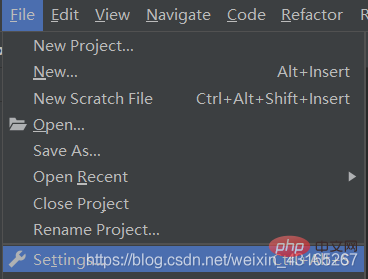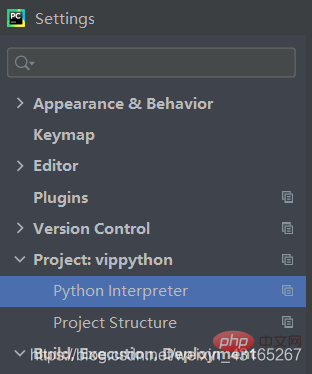Home >Backend Development >Python Tutorial >Introduction to python crawling web pages
Introduction to python crawling web pages
- coldplay.xixiforward
- 2021-03-09 10:03:203922browse

I have written a lot of code about crawlers crawling web pages on the Internet before. Recently, I still want to record the crawlers I wrote so that everyone can use them. Bar!
The code is divided into 4 parts:
Part 1: Find a website.
我这里还是找了一个比较简单的网站,就是大家都知道的https://movie.douban.com/top250?start= 大家可以登录里面看一下。
Here you may have some libraries that have not been installed. The above picture will let you install the libraries needed to crawl web pages. Among them, the libraries I used this time are: bs4, urllib, xlwt, re.
(Free learning recommendation: python video tutorial)
As shown


Select file here -setting-Project-then select the plus sign in the lower left corner and install the files you need by yourself.
The following code is the source code for crawling web pages:
import urllib.requestfrom bs4 import BeautifulSoupimport xlwtimport redef main():
# 爬取网页
baseurl = 'https://movie.douban.com/top250?start='
datalist = getData(baseurl)
savepath = '豆瓣电影Top250.xls'
# 保存数据
saveData(datalist,savepath)
# askURL("https://movie.douban.com/top250?start=1")#影片详情的规则findLink = re.compile(r'<a>') #创建从正则表达式,表示规则findImgSrc = re.compile(r'<img class="title lazy" src="/static/imghwm/default1.png" data-src="(.*?)" . alt="Introduction to python crawling web pages" >(.*)')#影片的评分findReating = re.compile(r'<span>(.*)</span>')#找到评价人数findJudge = re.compile(r'<span>(\d*)人评价</span>')#找到概况findInq = re.compile(r'<span>(.*)</span>')#找到影片的相关内容findBb = re.compile(r'<p>(.*?)</p>', re.S)#re.S忽视换行符</a>
Part 2: Crawl web pages.
def getData(baseurl):
datalist = []
for i in range(0, 10):
url = baseurl + str(i*25)
html = askURL(url) #保存获取到的网页源码
#对网页进行解析
soup = BeautifulSoup(html, 'html.parser')
for item in soup.find_all('p', class_="item"): #查找符合要求的字符串 形成列表
#print(item) #测试查看电影信息
data = []
item = str(item)
link = re.findall(findLink, item)[0] #re库用来查找指定的字符串
data.append(link)
imgSrc = re.findall(findImgSrc, item)[0]
data.append(imgSrc) #添加图片
titles = re.findall(finTitle, item) #
if (len(titles) == 2):
ctitle = titles[0] #添加中文名
data.append(ctitle)
otitle = titles[1].replace("/", "") #replace("/", "")去掉无关的符号
data.append(otitle) #添加英文名
else:
data.append(titles[0])
data.append(' ')#外国名字留空
rating = re.findall(findReating, item)[0] #添加评分
data.append(rating)
judgeNum = re.findall(findJudge,item) #评价人数
data.append(judgeNum)
inq = re.findall(findInq, item) #添加概述
if len(inq) != 0:
inq = inq[0].replace(".", "") #去掉句号
data.append(inq)
else:
data.append(" ") #留空
bd = re.findall(findBb,item)[0]
bd = re.sub('<br>(\s+)?',' ', bd) #去掉br 后面这个bd表示对bd进行操作
bd = re.sub('/', ' ', bd) #替换/
data.append(bd.strip()) #去掉前后的空格strip()
datalist.append(data) #把处理好的一部电影放入datalist当中
return datalist
Part 3: Get a specified url information.
#得到指定的一个url网页信息def askURL(url):
head = {
"User-Agent": "Mozilla/5.0 (Linux; Android 6.0; Nexus 5 Build/MRA58N) AppleWebKit/537.36 (KHTML, like Gecko) Chrome/87.0.4280.141 Mobile Safari/537.36"}
request = urllib.request.Request(url,headers=head) # get请求不需要其他的的,而post请求需要 一个method方法
html = ""
try:
response = urllib.request.urlopen(request)
html = response.read().decode('utf-8')
# print(html)
except Exception as e:
if hasattr(e,'code'):
print(e.code)
if hasattr(e,'reason'):
print(e.reason)
return html
Part 4: Saving Data
# 3:保存数据def saveData(datalist,savepath):
book = xlwt.Workbook(encoding="utf-8", style_compression=0)
sheet = book.add_sheet('豆瓣电影Top250', cell_overwrite_ok=True)
col = ('电影详情链接', '图片链接', '影片中文名', '影片外国名', '评分', '评价数', '概况', '相关信息')
for i in range(0,8):
sheet.write(0,i,col[i]) #列名
for i in range(0,250):
print("第%d条"%i)
data = datalist[i]
for j in range(0,8):
sheet.write(i+1,j,data[j])
book.save(savepath) #保存
Here, let’s take a look at the code. I wrote it very clearly about the annotation of the code.
Regarding learning this crawler, you also need to learn some basic regular expressions. Of course, basic python syntax is indispensable. I hope it will be helpful to everyone.
Related free learning recommendations: python tutorial(Video)
The above is the detailed content of Introduction to python crawling web pages. For more information, please follow other related articles on the PHP Chinese website!

